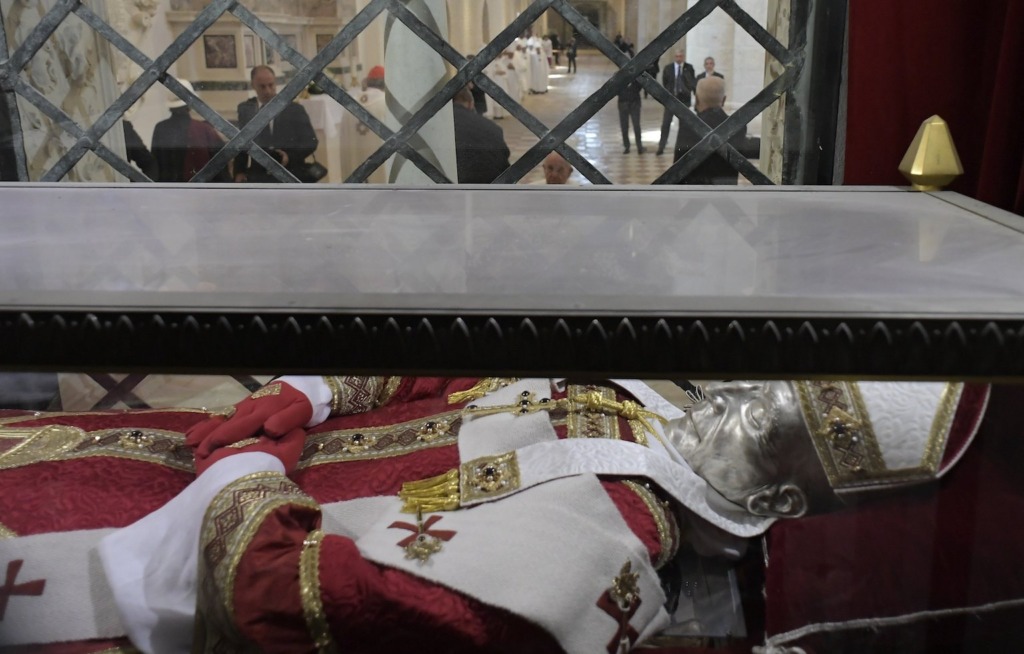On Sunday, Aug. 28, the day after the consistory during which he created 20 cardinals, Pope Francis traveled to L’Aquila to celebrate Mass for those commemorating “the Celestine Forgiveness.” Some have described this annual event, which dates to 1294, as a “celebration of forgiveness.”
Following the death of Pope Nicholas IV in 1292, the Church had been without a pope for 27 months due to an impasse in the College of Cardinals. Pietro Angeleri was an 85-year-old Benedictine monk living in a mountainside hermitage just outside of Sulmona, Italy. He sent a message to the cardinals telling them to elect someone. They viewed that as a message from the Holy Spirit and elected the monk who took the name Celestine V.
He was so reluctant to be pope that the cardinals went to the hermitage and brought Celestine back to Perugia, where they had been meeting, to consecrate him. A month later, he issued what is known as the “bull of forgiveness” in which he granted a plenary indulgence on Aug. 28-29 to all who make a pilgrimage to the Basilica of Santa Maria di Collemaggio in L’Aquila, and go to confession, attend Mass, receive Communion and pray for the intentions of the pope.
In part, the bull read, “… annually we absolve from guilt and punishment, which they deserve for all their sins, committed since baptism, to all those who truly repentant and confessed, enter said church from the eve of the vigil of the feast of St. Juan (John the Baptist) until the eve immediately following the feast.”
Within five months of his election, Celestine resigned the papacy with the hope of returning to the hermitage. However, his successor, Pope Boniface VIII, had him imprisoned, where he died 17 months later.
Although I have not participated in this pilgrimage, I have visited the hermitage, and I have an affinity for that area as my maternal grandfather came from Pacentro, a town in the vicinity of Sulmona, on the same mountain where the hermitage, while no longer occupied, stands. One can look from the mountains over the Sulmona Valley and imagine what it might have been like for pilgrims over the centuries who have made their way from the hermitage to L’Aquila in order to receive this absolution.
Pope Francis’ visit highlighted themes of his pontificate: mercy and forgiveness. When he spoke about mercy, he noted that the path to it is through personal suffering. Having been devastated by an earthquake in 2009, the residents of L’Aquila could relate when the pope said, “(God) is mercy, and it is only with his mercy that he can speak to our misery.”
We know that sin is a form of misery and a cause of it. We also know that forgiveness is integral to God’s mercy, his willingness to forgive whatever we do. Pope Francis emphasized that point: “Mercy is the experience of feeling welcomed, put back on our feet, strengthened, healed, encouraged. To be forgiven is to experience here and now that which comes closest to being resurrected. Forgiveness is the passage from death to life, from the experience of anguish and guilt to that of freedom and joy.”
Those words warrant reflection which will, through the sacraments of Eucharist and reconciliation, lead each of us to accept what God freely offers and through which he invites us to be with him. As we accept that invitation, let us make the words of Pope Francis a reality in our homes, parishes and diocese:
“May this Church always be a place in which people can be reconciled and experience that grace that puts us back on our feet and gives us another chance. Our God is the God of second chances. … It is God who always gives you another chance. May it be a Church of forgiveness, not once a year, but always, every day. For in this way peace is constructed, through forgiveness that is received and given.”

